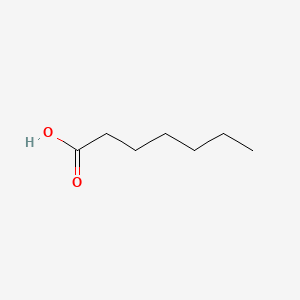| MeSH term | MeSH ID | Detail |
|---|---|---|
| Olfaction Disorders | D000857 | 17 associated lipids |
| Byssinosis | D002095 | 11 associated lipids |
| Mitochondrial Diseases | D028361 | 25 associated lipids |
HEPTANOIC ACID
HEPTANOIC ACID is a lipid of Fatty Acyls (FA) class. Heptanoic acid is associated with abnormalities such as Dehydration. The involved functions are known as Process, Anabolism, inhibitors, Oxidation and fatty acid oxidation. The related lipids are Heptanoates and undecanoic acid.
Cross Reference
Introduction
To understand associated biological information of HEPTANOIC ACID, we collected biological information of abnormalities, associated pathways, cellular/molecular locations, biological functions, related genes/proteins, lipids and common seen animal/experimental models with organized paragraphs from literatures.
What diseases are associated with HEPTANOIC ACID?
HEPTANOIC ACID is suspected in Dehydration and other diseases in descending order of the highest number of associated sentences.
Related references are mostly published in these journals:
| Disease | Cross reference | Weighted score | Related literature |
|---|
Possible diseases from mapped MeSH terms on references
We collected disease MeSH terms mapped to the references associated with HEPTANOIC ACID
PubChem Associated disorders and diseases
What pathways are associated with HEPTANOIC ACID
There are no associated biomedical information in the current reference collection.
PubChem Biomolecular Interactions and Pathways
Link to PubChem Biomolecular Interactions and PathwaysWhat cellular locations are associated with HEPTANOIC ACID?
There are no associated biomedical information in the current reference collection.
What functions are associated with HEPTANOIC ACID?
Related references are published most in these journals:
| Function | Cross reference | Weighted score | Related literatures |
|---|
What lipids are associated with HEPTANOIC ACID?
Related references are published most in these journals:
| Lipid concept | Cross reference | Weighted score | Related literatures |
|---|
What genes are associated with HEPTANOIC ACID?
There are no associated biomedical information in the current reference collection.
What common seen animal models are associated with HEPTANOIC ACID?
There are no associated biomedical information in the current reference collection.
NCBI Entrez Crosslinks
All references with HEPTANOIC ACID
Download all related citations| Authors | Title | Published | Journal | PubMed Link |
|---|---|---|---|---|
| Ventura R et al. | Quantification of perphenazine in eurasian otter (Lutra lutra lutra) urine samples by gas chromatography-mass spectrometry. | 2002 | J. Chromatogr. B Analyt. Technol. Biomed. Life Sci. | pmid:11936697 |
| O'Connor DB et al. | Exogenous testosterone, aggression, and mood in eugonadal and hypogonadal men. | 2002 | Physiol. Behav. | pmid:12062320 |
| Cherrier MM et al. | Cognitive effects of short-term manipulation of serum sex steroids in healthy young men. | 2002 | J. Clin. Endocrinol. Metab. | pmid:12107206 |
| Gonzalo IT et al. | Levonorgestrel implants (Norplant II) for male contraception clinical trials: combination with transdermal and injectable testosterone. | 2002 | J. Clin. Endocrinol. Metab. | pmid:12161475 |
| Ueda T et al. | Response of Nitella internodal cell to chemical stimulation. A model for olfactory receptor system. | 1975-1976 | J. Membr. Biol. | pmid:1235804 |
| Amory JK et al. | Preoperative supraphysiological testosterone in older men undergoing knee replacement surgery. | 2002 | J Am Geriatr Soc | pmid:12366624 |
| Goodnick PJ et al. | Antipsychotics: impact on prolactin levels. | 2002 | Expert Opin Pharmacother | pmid:12387684 |
| Klatt CG and LaPara TM | Aerobic biological treatment of synthetic municipal wastewater in membrane-coupled bioreactors. | 2003 | Biotechnol. Bioeng. | pmid:12599258 |
| Altamura AC et al. | Intramuscular preparations of antipsychotics: uses and relevance in clinical practice. | 2003 | Drugs | pmid:12600227 |
| Herbst KL et al. | The male contraceptive regimen of testosterone and levonorgestrel significantly increases lean mass in healthy young men in 4 weeks, but attenuates a decrease in fat mass induced by testosterone alone. | 2003 | J. Clin. Endocrinol. Metab. | pmid:12629101 |
